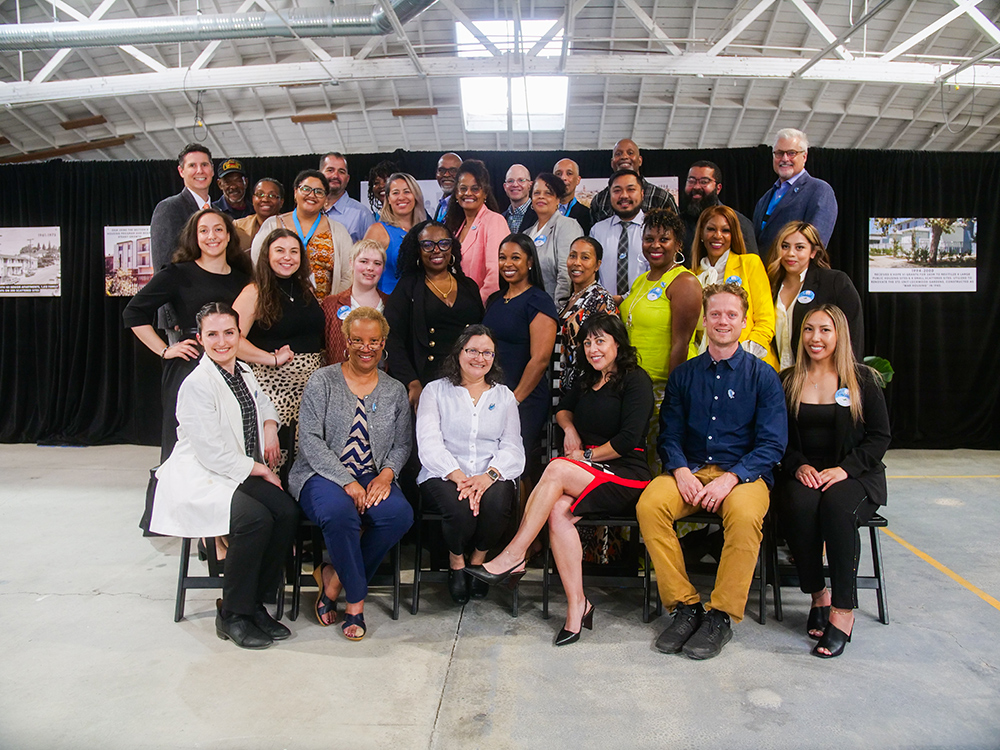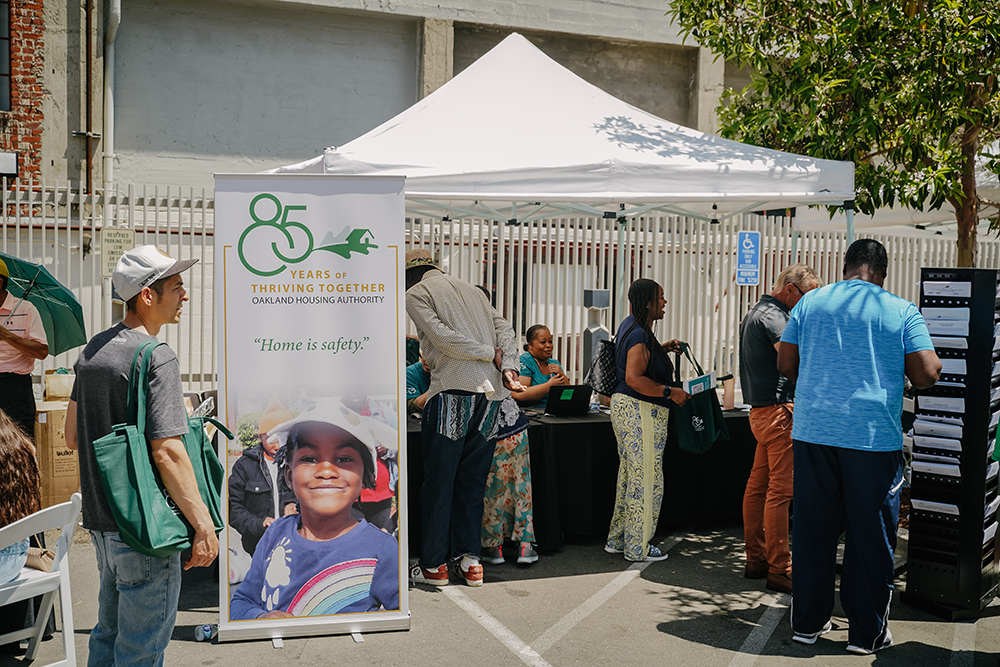
History
History
Celebrating Over 80 Years of Progress
The Housing Authority of the City of Oakland, California or “Oakland Housing Authority” was founded April 28, 1938, by a City of Oakland ordinance under the Health and Safety Code of the State of California. The Authority was established to receive federal funds to provide housing for low-income residents of the City of Oakland, California.
2020-Present
2020: Developed innovative strategies to assist families during the Coronavirus Pandemic; led to grocery deliveries and enrichment activity deliveries for seniors, as well as connecting with residents via zoom.
2022: Awarded a Jobs Plus grant for $2.3M for East Oakland residents.
2023: 85th Anniversary
2024: Celebrated 20 years as a member of the Moving to Work Demonstration


2019-2010
2019: Consistently served 12,000 households in the traditional public housing and HCV program.
2018: Oakland Housing Authority celebrates its 80th Anniversary and 80 years of service to the residents of Oakland, California.
2015
- Awarded the Jobs Plus Grant for West Oakland.
- Established Learning Labs for residents to access computers with Wi-Fi and employment trainings
2013
- In partnership with Satellite Affordable Housing Associates (SAHA), the substantial rehabilitation of two former single room occupancy hotels was completed and reopened as The Savoy (101 studios for very low-income adults).
- In partnership with SAHA, Lakeside Senior (92 units for seniors) breaks ground.
- Lion Creek Crossings Phase 5 (128 units for seniors) breaks ground.
- Oakland Housing Authority celebrates its 75th Anniversary.
2012
- In partnership with EAH Housing, Cathedral Gardens (100 units for families) breaks ground. The development includes the adaptive re-use of a historic rectory and the new construction of two multi-family structures on adjoining parcels.
- In partnership with Christian Church Homes, Harrison Street Senior (73 units for seniors) is completed.
- In partnership with Keller Housing Associates, L.P.(an affiliated corporation of the Oakland Housing Authority), the substantial rehabilitation of Keller Plaza (201 units for families) is completed.
2011
- In partnership with Related and EBALDC, Lion Creek Crossings Phase 4 (72 units for families) is completed.
- The new 5-acre Lion Creek Park and the restoration of Lion Creek is completed.
- Tassafaronga Village is awarded the Housing Award by the American Institute of Architects (AIA).
2010
The Authority completes the redevelopment of the original 87-unit Tassafaronga Village to newly create 157-units for families in an award-winning community that includes the highest green building credentials: LEED for Homes – Platinum and LEED for Neighborhood Development – Gold.

2009-2000
2009: Lion Creek Crossings is awarded the National Association of Housing and Redevelopment Officials (NAHRO) National Award of Excellence.
2008
- The Authority’s Section 8 program reaches 11,000 units in size.
- Tassafaronga Village public housing complex is vacated and demolished, making way for a new development.
- Foothill Family Apartments is completed.
- In partnership with Related and EBALDC, Lion Creek Crossings Phase 3 (106 units for families) is completed.
2007
In partnership with Related and EBALDC, Lion Creek Crossings Phase 2 (146 units for families) is completed.
2005
- In partnership with Bridge Housing, Mandela Gateway (168 units for families) was completed as part of a HOPE VI master plan to replace the former Westwood Gardens public housing complex and revitalize this critical West Oakland neighborhood. Mandela Gateway also includes for-sale units and 20,000 square feet of retail space.
- Mandela Gateway is awarded the San Francisco Business Times’ Real Estate Deal of the Year for Affordable Residential Development.
2004
- The Authority became a Moving to Work agency, one of only about 35 agencies at the time so designated from the 3,200 agencies throughout the country.
- The Authority was selected in a competitive process to administer HUD’s project-based rental assistance program for northern California.
- Lion Creek Crossings Phase 1 (115 units for families) begins construction. The Authority partners with the East Bay Asian Local Development Corporation (EBALDC) and The Related Company (Related) to redevelop the former Coliseum Gardens public housing complex near the Oakland Coliseum and Arena in five phases utilizing HOPE VI funds. Lion Creek Crossings Phase I broke ground in November 2004 and was completed in 2006.
2003
- Chestnut Linden Court is completed by Authority partner BRIDGE Housing utilizing HOPE VI funds to create 151 units for families, a childcare center, and ground floor retail space.
- Chestnut Linden Court is awarded the PG&E Flex Your Power Award for Energy Efficiency.

1999-1980
1995–Today: The Authority leverages HOPE VI with private investment to replace 394 public housing apartments with nearly 1000 affordable rental units and 81 homeownership units.
1994, 1998, 1999 and 2000
The Authority received five federal HOPE VI grants totaling $83 million, enabling it to revitalize four large public housing sites and four small, scattered sites. OHA’s first HOPE grant was used to renovate one of OHA’s original “war housing” developments, the 372-unit Lockwood Gardens, constructed in 1943.
1984
Three senior apartment complexes were added to OHA’s housing stock: Adel Court, Oak Grove North, and Oak Grove South for a total of 182 apartments.
1981
The OHA Security Department obtained peace officer status, allowing it to supplement the Oakland Police Department to better serve our residents and staff.

1970-1938
1974: The Authority converted its Section 23 leased housing program to Section 8 and began the steady growth of the program.
1972: The Authority added its own security department.
1969–1973
The Authority more than doubled in size with the addition of its 101-apartment tower for seniors and 1,621 family apartments on 255 scattered sites.
1965
The Authority began participating in a new program known as Section 23 allowing PHAs to sublet units from private Affordable Housing Providers. The program soon grew to more than 1,400 privately-owned units.
1964–1966
Four additional family developments (San Antonio Villa, Chestnut Court, Tassafaronga Village, and Westwood Gardens) with over 400 apartments and the 100-unit senior site (Palo Vista Gardens) were built.
1938–1943
Three initial developments with more than 900 apartments were built in east and west Oakland (Peralta Villa, Campbell Village and Lockwood Gardens). Campbell Village and Lockwood Gardens, sometimes called war housing, were both opened to local shipyard workers during World War II.

